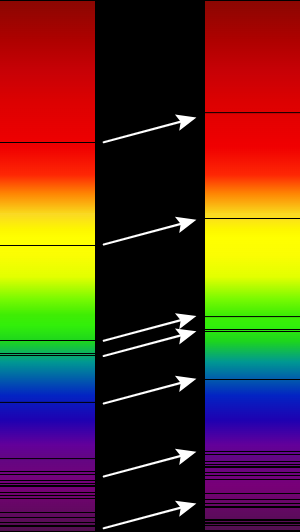In 1929, Edwin Hubble noticed that distant galaxies looked redder than those nearby. Moreover, the further away they are, the redder they tend to look. This observation, known as redshift, allowed us to measure the distances to galaxies too distant to determine by other means. It was also revealed that the universe is expanding, with all its components flying apart from each other unless they are close enough that gravity holds them together.
The connection is so built-in to cosmology that articles on it, including our own, sometimes skip over the explanation, so this aims to fill the gap.
If you’ve ever been passed by a motorbike or an emergency vehicle, you’re probably familiar with the way the pitch changes, higher as it approaches, and lower as it moves away. This is known as Doppler Shift, after Christian Doppler who observed it once transportation started moving fast enough for it to become noticeable.
The shift occurs because the vehicles are traveling at a significant fraction of the speed of sound. As they move towards us this causes the sound waves to become bunched up, equivalent to a shorter wavelength, which means a higher pitch. Once the source is moving away, the sound waves spread out, creating a lower pitch than if they were coming from something stationary.
Light also travels in waves, with red light having longer wavelengths than blue. The same bunching on approach and spread on departing occurs. When the waves spread out they are referred to as “redshifted”. However, because light in a vacuum travels almost a million times faster than sound in air, it is necessary for a source to be moving very fast before the shift is noticeable.
That’s why, despite the physicists’ jokey bumper sticker reading, “If this sticker looks blue you’re traveling too fast”, we hear, but don’t see, the Doppler effect in our everyday lives
Scaling the universe
Hubble noticed the redshift because some of the galaxies he was studying were traveling away from us very fast indeed – not close to the speed of light, but enough to cause a noticeable bunching.
Fortunately, to measure red- (or blue-) shift astronomers don’t have to rely on looking at an object and asking, “Does that look a bit pink to you?” When heated, objects give off a broad spectrum of electromagnetic radiation. However, once hot enough to become gases, the light released has extra intensity at certain wavelengths specific to the elements present.
A source’s redshift can be identified by looking at the wavelengths where familiar emission or absorption lines are found.
Some of these patterns, such as orange double lines produced by sodium, are easy to recognize even when they have been shifted to substantially different wavelengths. If we find that pair at yellow wavelengths, we know the source is coming towards us. If they’re in the red, it’s moving away. If they’re in the infrared, it’s moving away fast.
Outside our local patch of the universe, the distances to galaxies are measured by the extent to which their light has been redshifted, represented by the letter z. Although this measures speed not distance, on a grand scale these two correlate so well that redshift becomes the most reliable measure.
Lots of other uses
Measuring the universe is a pretty big deal (technically the biggest deal there is), but it’s not the only way in which redshift has transformed astronomy, although in the other cases it needs some help from blueshift.
We measure the rates at which galaxies and the accretion disks around black holes, among other things, are turning by detecting the redshift on the side turning away from us, and the blue on the limb moving towards us. If the whole object is also moving relative to us, such as a galaxy moving away, we may be seeing a redshift on both sides. However, the shift will be larger where the away movements combine than where the two motions counteract each other.
A particularly important application is in finding exoplanets (planets orbiting other stars). With rare exceptions, the light from these is so overwhelmed by the star itself that we can’t see them directly with existing equipment, so have to get creative.
One way to do that is to observe when stars move slightly on regular cycles for no reason we can see. This suggests they are being acted on by the gravitational force of an unseen object, almost always a planet. By measuring the size of the movement, and the period over which it repeats, we can determine the planet’s mass and its orbit.
You might think it would be easiest to track the way the star moves side to side from our perspective, but that’s not the case. Instead, we can achieve much more precision by watching for movements towards and away from us, detected through very slight alternating red- and blueshifts.
Until the launch of the Kepler satellite, this “Doppler wobble” method was the main way exoplanets were detected. Even today, when Kepler and TESS have alerted us to thousands of candidate exoplanets through observing transits, red- and blueshifts are used to confirm suspects and determine their mass.
All “explainer” articles are confirmed by fact checkers to be correct at time of publishing. Text, images, and links may be edited, removed, or added to at a later date to keep information current.
Source Link: What Are Redshift And Blueshift And Why Do They Matter?
